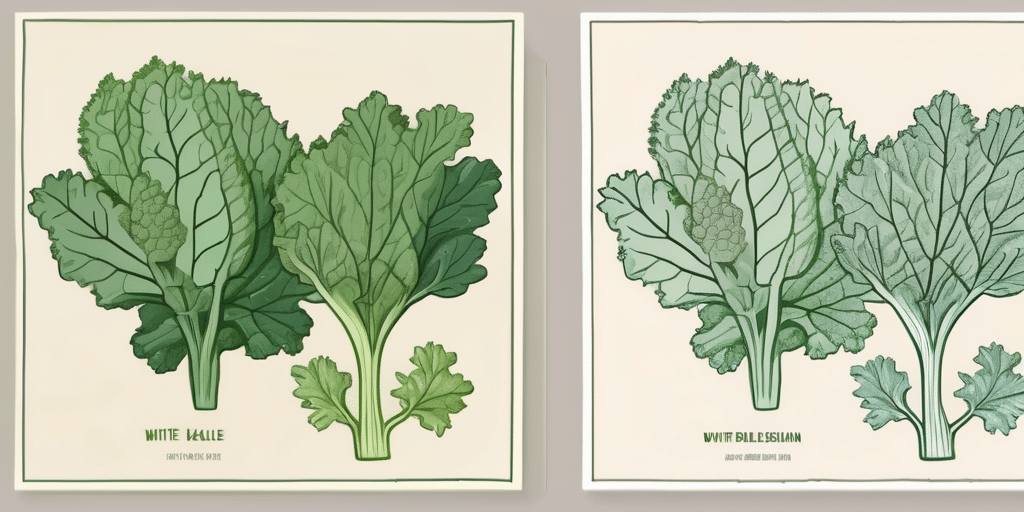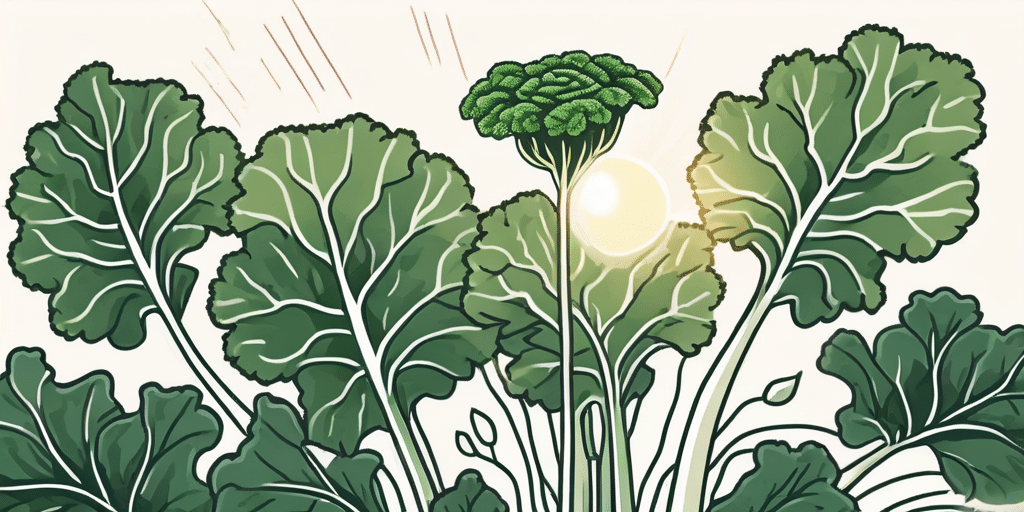In the world of leafy greens, kale reigns supreme. Its versatility, nutritional value, and unique flavor have made it a staple in many diets. If you’re a fan of kale, you may have come across two popular varieties: Red Ursa Kale and Winterbor Kale. In this article, we’ll delve into the similarities, differences, and benefits of these two kale varieties to help you make an informed choice for your next kale adventure.
What is Red Ursa Kale?
Red Ursa Kale is a visually striking variety of kale that features beautiful, dark red leaves and sturdy stems. It belongs to the Brassica oleracea species, which includes other popular vegetables like broccoli and cabbage. Red Ursa Kale is known for its slightly sweet and earthy flavor, making it a delightful addition to salads and stir-fries.
One interesting fact about Red Ursa Kale is that its vibrant red color comes from high levels of anthocyanins, which are powerful antioxidants that have been linked to various health benefits, including reducing inflammation and improving heart health. This kale variety not only pleases the taste buds but also provides a visual feast for the eyes, making it a favorite among chefs and home cooks alike.
Pros of Red Ursa Kale:
- High in vitamins A, C, and K
- Rich in antioxidants
- Good source of fiber
- Beautiful color adds vibrancy to dishes
Additionally, Red Ursa Kale is a versatile ingredient that can be enjoyed raw in salads, sautéed as a side dish, or even blended into smoothies for an extra nutrient boost. Its robust flavor profile allows it to pair well with a variety of ingredients, from tangy citrus fruits to creamy cheeses, offering endless culinary possibilities.
Cons of Red Ursa Kale:
- Can have a slightly bitter taste if not cooked properly
- Slightly tougher texture compared to other kale varieties
While Red Ursa Kale offers numerous health benefits and culinary advantages, some may find its slightly bitter taste off-putting if not prepared with care. To mitigate this, massaging the kale leaves with a bit of olive oil or lemon juice can help soften its texture and mellow out any bitterness, ensuring a more enjoyable dining experience. Despite these minor drawbacks, the unique flavor and visual appeal of Red Ursa Kale make it a standout choice for anyone looking to elevate their dishes with a touch of elegance and nutrition.
What is Winterbor Kale?
Winterbor Kale, also known as Curly Kale, is a classic variety with tightly curled leaves that range in color from deep green to vibrant purple. Like Red Ursa Kale, it belongs to the Brassica oleracea species. Winterbor Kale is known for its robust flavor and versatility in various dishes, from soups and stews to smoothies and chips.
One interesting fact about Winterbor Kale is that its tightly curled leaves not only add a decorative touch to dishes but also help retain nutrients during cooking. The curly edges trap steam and prevent water-soluble vitamins from escaping, making it a nutritious choice for those looking to maximize the health benefits of their meals.
Pros of Winterbor Kale:
- Packed with vitamins A, C, and K
- High in antioxidants
- Excellent source of fiber
- Frilly leaves add texture and visual appeal to dishes
Another advantage of Winterbor Kale is its adaptability to various growing conditions. This cold-hardy vegetable thrives in cooler temperatures, making it a popular choice for winter gardens. Its ability to withstand frost allows for extended harvest periods, providing a fresh supply of nutritious greens even in the coldest months.
Cons of Winterbor Kale:
- Slightly bitter taste compared to other kale varieties
- Curled leaves may require more thorough cleaning
While Winterbor Kale offers a plethora of health benefits, some may find its slightly bitter taste off-putting. However, this bitterness can be easily balanced with the right combination of ingredients in recipes. Additionally, the intricate curls of Winterbor Kale leaves may trap dirt and debris, requiring extra care during the cleaning process to ensure a pristine final product.
Is Red Ursa Kale or Winterbor Kale Right for You?
Choosing between Red Ursa Kale and Winterbor Kale ultimately comes down to personal preference and intended use. If you’re looking for a kale variety that adds a pop of color to your meals and has a slightly sweeter taste, Red Ursa Kale might be the perfect choice for you. On the other hand, if you enjoy the robust flavor and texture of tightly curled leaves, Winterbor Kale might be your go-to variety.
Regardless of your choice, both Red Ursa Kale and Winterbor Kale offer outstanding nutritional value. They are low in calories and high in vitamins, minerals, and antioxidants, making them excellent additions to a healthy diet.
Red Ursa Kale, with its vibrant red-purple leaves, not only adds visual appeal to dishes but also provides a good dose of vitamin A and vitamin C. This variety of kale is known for its tender leaves, which work well in salads or as a garnish. Red Ursa Kale is also a versatile ingredient that can be sautéed, steamed, or even baked into crispy kale chips.
On the other hand, Winterbor Kale, with its dark green, heavily ruffled leaves, is a powerhouse of nutrients. It is particularly rich in vitamin K, which is essential for bone health and blood clotting. The sturdy leaves of Winterbor Kale hold up well in soups and stews, adding a hearty texture and flavor to the dish. This kale variety is also a great option for juicing or blending into smoothies to boost your daily intake of vitamins and minerals.
Frequently Asked Questions
Q: Can I eat Red Ursa Kale and Winterbor Kale raw?
A: Absolutely! Both Red Ursa Kale and Winterbor Kale can be enjoyed raw in salads, smoothies, or as crunchy kale chips. Raw kale is not only delicious but also packed with nutrients like vitamin K, vitamin C, and antioxidants. Eating kale raw helps retain its maximum nutritional value, making it a great addition to your diet.
If you’re looking for a refreshing salad idea, try combining raw kale with some sliced strawberries, crumbled feta cheese, and a balsamic vinaigrette dressing. The combination of flavors creates a delightful and healthy dish that is perfect for a light lunch or as a side for dinner.
Q: How do I prepare Red Ursa Kale and Winterbor Kale for cooking?
A: To prepare Red Ursa Kale or Winterbor Kale for cooking, start by removing the leaves from the tough stems. Rinse the leaves thoroughly under cold water to remove any dirt or debris. You can then chop or tear the leaves into bite-sized pieces, depending on your preference. Cooking kale helps to soften its texture and mellow out its slightly bitter taste.
For a simple and delicious cooking method, try sautéing kale with some minced garlic, olive oil, and a sprinkle of red pepper flakes. The garlic adds a savory flavor, while the red pepper flakes give a hint of heat to the dish. This quick and easy side dish pairs well with grilled chicken or fish.
Q: Can I freeze Red Ursa Kale or Winterbor Kale?
A: Yes, both Red Ursa Kale and Winterbor Kale can be frozen for later use. To freeze, blanch the kale for a couple of minutes, then transfer it to an airtight container or freezer bag. Frozen kale can be added to soups, stews, or smoothies directly from the freezer. Freezing kale is a convenient way to preserve this leafy green for future use, ensuring you always have some on hand for your favorite recipes.
When using frozen kale in smoothies, try blending it with some frozen berries, a banana, and a splash of almond milk for a nutritious and refreshing drink. The frozen kale adds a boost of vitamins and minerals to your smoothie without compromising on taste.
Now armed with knowledge about the distinctive qualities of Red Ursa Kale and Winterbor Kale, you can confidently experiment with these two kale varieties and enjoy their unique flavors and nutritional benefits.
Join the How to Grow Everything Community
Ready to take your kale-growing journey to the next level? Subscribe for free to How to Grow Everything and learn how to build the garden of your dreams! Receive personalized gardening advice tailored to your location, grow zone, and experience. Enjoy the best gardening tips, special offers, and insightful articles, all delivered directly to your inbox. Join our family of gardening enthusiasts and make the most out of your kale varieties and beyond. It’s 100% free, with no spam, just the support you need to grow everything successfully!






